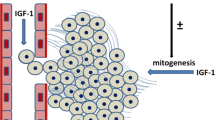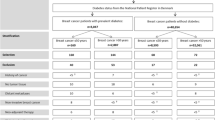Abstract
The growth hormone and insulin-like growth factor (IGF) axis plays an essential role in the growth and development of the mammary gland. IGF1 and IGF1 receptor (IGF1R) may also play a role in the early transformation of mammary cells. Using a nested case–control design, the association between IGF1R expression in normal breast tissue from benign biopsies and subsequent risk of breast cancer was examined in patients enrolled in the Nurses’ Health Study. The tissue microarrays (TMAs) containing normal terminal duct lobular units (TDLUs) from benign breast biopsies were constructed. Immunostains for IGF1R were performed on sections cut from the TMAs. A total of 312 women had evaluable IGF1R staining in normal TDLUs; 75 subsequently developed breast cancer (cases) and 237 did not (controls). The epithelial cells in the normal TDLUs were scored for both cytoplasmic and membrane staining for IGF1R. Cytoplasmic IGF1R expression was positively associated with subsequent risk of breast cancer (OR = 2.47, 95% CI 1.41–4.33). Women having TDLU epithelial cells showed little or no membrane expression of IGF1R, but those with high levels of cytoplasmic IGF1R were at the highest breast cancer risk and were 15 times more likely to develop subsequent breast cancer when compared with women who had little or no membrane or cytoplasmic IGF1R expression in their TDLU epithelial cells (OR = 15.9, 95% CI 3.6–69.8). In this study, it was demonstrated that IGF1R expression patterns in epithelial cells of normal TDLUs in benign breast biopsies were associated with an increased risk of subsequent breast cancer. Further studies to confirm these findings are necessary.



Similar content being viewed by others
Abbreviations
- ADH:
-
Atypical ductal hyperplasia
- ALH:
-
Atypical lobular hyperplasia
- BBD:
-
Benign breast disease
- BMI:
-
Body mass index
- CI:
-
Confidence interval
- ER:
-
Estrogen receptor
- H&E:
-
Hematoxylin and eosin
- IGF:
-
Insulin-like growth factor
- IGF1R:
-
Insulin-like growth factor receptor
- IRS1:
-
Insulin receptor substrate 1
- NHS:
-
Nurses’ Health Study.
- OR:
-
Odds Ratio
- PI3K:
-
Phosphatidyl inositol-3 kinase
- PR:
-
Progesterone receptor
- TDLUs:
-
Normal terminal ductal lobular units
- TMAs:
-
Tissue microarrays
References
Pollak MN, Schernhammer ES, Hankinson SE (2004) Insulin-like growth factors and neoplasia. Nat Rev Cancer 4(7):505–518
Rubin R, Baserga R (1995) Insulin-like growth factor-I receptor. Its role in cell proliferation, apoptosis, and tumorigenicity. Lab Invest 73(3):311–331
Renehan AG, Zwahlen M, Minder C, O’Dwyer ST, Shalet SM, Egger M (2004) Insulin-like growth factor (IGF)-I, IGF binding protein-3, and cancer risk: systematic review and meta-regression analysis. Lancet 363(9418):1346–1353
Renehan AG, Harvie M, Howell A (2006) Insulin-like growth factor (IGF)-I, IGF binding protein-3, and breast cancer risk: eight years on. Endocr Relat Cancer 13(2):273–278
Rinaldi S, Peeters PH, Berrino F, Dossus L, Biessy C, Olsen A, Tjonneland A, Overvad K, Clavel-Chapelon F, Boutron-Ruault MC, Tehard B, Nagel G, Linseisen J, Boeing H, Lahmann PH, Trichopoulou A, Trichopoulos D, Koliva M, Palli D, Panico S, Tumino R, Sacerdote C, van Gils CH, van Noord P, Grobbee DE, Bueno-de-Mesquita HB, Gonzalez CA, Agudo A, Chirlaque MD, Barricarte A, Larranaga N, Quiros JR, Bingham S, Khaw KT, Key T, Allen NE, Lukanova A, Slimani N, Saracci R, Riboli E, Kaaks R (2006) IGF-I, IGFBP-3 and breast cancer risk in women: The European Prospective Investigation into Cancer and Nutrition (EPIC). Endocr Relat Cancer 13(2):593–605
Schernhammer ES, Holly JM, Hunter DJ, Pollak MN, Hankinson SE (2006) Insulin-like growth factor-I, its binding proteins (IGFBP-1 and IGFBP-3), and growth hormone and breast cancer risk in The Nurses Health Study II. Endocr Relat Cancer 13(2):583–592
Schernhammer ES, Holly JM, Pollak MN, Hankinson SE (2005) Circulating levels of insulin-like growth factors, their binding proteins, and breast cancer risk. Cancer Epidemiol Biomarkers Prev 14(3):699–704
Papa V, Gliozzo B, Clark GM, McGuire WL, Moore D, Fujita-Yamaguchi Y, Vigneri R, Goldfine ID, Pezzino V (1993) Insulin-like growth factor-I receptors are overexpressed and predict a low risk in human breast cancer. Cancer Res 53(16):3736–3740
Arteaga CL, Osborne CK (1989) Growth inhibition of human breast cancer cells in vitro with an antibody against the type I somatomedin receptor. Cancer Res 49(22):6237–6241
Brunner N, Spang-Thomsen M, Cullen K (1996) The T61 human breast cancer xenograft: an experimental model of estrogen therapy of breast cancer. Breast Cancer Res Treat 39(1):87–92
Jones RA, Campbell CI, Gunther EJ, Chodosh LA, Petrik JJ, Khokha R, Moorehead RA (2007) Transgenic overexpression of IGF-IR disrupts mammary ductal morphogenesis and induces tumor formation. Oncogene 26(11):1636–1644
Carboni JM, Lee AV, Hadsell DL, Rowley BR, Lee FY, Bol DK, Camuso AE, Gottardis M, Greer AF, Ho CP, Hurlburt W, Li A, Saulnier M, Velaparthi U, Wang C, Wen ML, Westhouse RA, Wittman M, Zimmermann K, Rupnow BA, Wong TW (2005) Tumor development by transgenic expression of a constitutively active insulin-like growth factor I receptor. Cancer Res 65(9):3781–3787
Hadsell DL, Murphy KL, Bonnette SG, Reece N, Laucirica R, Rosen JM (2000) Cooperative interaction between mutant p53 and des(1–3)IGF-I accelerates mammary tumorigenesis. Oncogene 19(7):889–898
Kleinberg DL, Wood TL, Furth PA, Lee AV (2009) Growth hormone and insulin-like growth factor-I in the transition from normal mammary development to preneoplastic mammary lesions. Endocr Rev 30(1):51–74
Rowinsky EK, Youssoufian H, Tonra JR, Solomon P, Burtrum D, Ludwig DL (2007) IMC-A12, a human IgG1 monoclonal antibody to the insulin-like growth factor I receptor. Clin Cancer Res 13(18 Pt 2):5549s–5555s
Feng Y, Zhu Z, Xiao X, Choudhry V, Barrett JC, Dimitrov DS (2006) Novel human monoclonal antibodies to insulin-like growth factor (IGF)-II that potently inhibit the IGF receptor type I signal transduction function. Mol Cancer Ther 5(1):114–120
Burtrum D, Zhu Z, Lu D, Anderson DM, Prewett M, Pereira DS, Bassi R, Abdullah R, Hooper AT, Koo H, Jimenez X, Johnson D, Apblett R, Kussie P, Bohlen P, Witte L, Hicklin DJ, Ludwig DL (2003) A fully human monoclonal antibody to the insulin-like growth factor I receptor blocks ligand-dependent signaling and inhibits human tumor growth in vivo. Cancer Res 63(24):8912–8921
Colditz GA, Hankinson SE (2005) The Nurses’ Health Study: lifestyle and health among women. Nat Rev Cancer 5(5):388–396
Collins LC, Baer HJ, Tamimi RM, Connolly JL, Colditz GA, Schnitt SJ (2006) The influence of family history on breast cancer risk in women with biopsy-confirmed benign breast disease: results from the Nurses’ Health Study. Cancer 107(6):1240–1247
Page DL, Dupont WD, Rogers LW, Rados MS (1985) Atypical hyperplastic lesions of the female breast. A long-term follow-up study. Cancer 55(11):2698–2708
Collins LC, Wang Y, Connolly JL, Baer HJ, Hu R, Schnitt SJ, Colditz GA, Tamimi RM (2009) Potential role of tissue microarrays for the study of biomarker expression in benign breast disease and normal breast tissue. Appl Immunohistochem Mol Morphol. 17(5):438–441 PMCID: PMC2783452
Schumacher R, Soos MA, Schlessinger J, Brandenburg D, Siddle K, Ullrich A (1993) Signaling-competent receptor chimeras allow mapping of major insulin receptor binding domain determinants. J Biol Chem 268(2):1087–1094
Soos MA, Nave BT, Siddle K (1993) Immunological studies of type I IGF receptors and insulin receptors: characterisation of hybrid and atypical receptor subtypes. Adv Exp Med Biol 343:145–157
Takahashi MH, Thomas GA, Williams ED (1995) Evidence for mutual interdependence of epithelium and stromal lymphoid cells in a subset of papillary carcinomas. Br J Cancer 72(4):813–817
Allred DC, Harvey JM, Berardo M, Clark GM (1998) Prognostic and predictive factors in breast cancer by immunohistochemical analysis. Mod Pathol 11(2):155–168
Happerfield LC, Miles DW, Barnes DM, Thomsen LL, Smith P, Hanby A (1997) The localization of the insulin-like growth factor receptor 1 (IGFR-1) in benign and malignant breast tissue. J Pathol 183(4):412–417
Atkins D, Reiffen KA, Tegtmeier CL, Winther H, Bonato MS, Storkel S (2004) Immunohistochemical detection of EGFR in paraffin-embedded tumor tissues: variation in staining intensity due to choice of fixative and storage time of tissue sections. J Histochem Cytochem 52(7):893–901
Sehat B, Tofigh A, Lin Y, Trocme E, Liljedahl U, Lagergren J, Larsson O (2010) SUMOylation mediates the nuclear translocation and signaling of the IGF-1 receptor. Sci Signal 3 (108):ra10. doi:3/108/ra10 [pii]10.1126/scisignal.2000628
Aleksic T, Chitnis MM, Perestenko OV, Gao S, Thomas PH, Turner GD, Protheroe AS, Howarth M, Macaulay VM (2010) Type 1 insulin-like growth factor receptor translocates to the nucleus of human tumor cells. Cancer Res 70(16):6412–6419 PMCID: PMC2981028
Tushir JS, Clancy J, Warren A, Wrobel C, Brugge JS, D’Souza-Schorey C (2010) Unregulated ARF6 activation in epithelial cysts generates hyperactive signaling endosomes and disrupts morphogenesis. Mol Biol Cell 21(13):2355–2366 PMCID: PMC2893997
Sorkin A, Goh LK (2009) Endocytosis and intracellular trafficking of ErbBs. Exp Cell Res 315(4):683–696
Romanelli RJ, LeBeau AP, Fulmer CG, Lazzarino DA, Hochberg A, Wood TL (2007) Insulin-like growth factor type-I receptor internalization and recycling mediate the sustained phosphorylation of Akt. J Biol Chem 282(31):22513–22524
Sehat B, Andersson S, Girnita L, Larsson O (2008) Identification of c-Cbl as a new ligase for insulin-like growth factor-I receptor with distinct roles from Mdm2 in receptor ubiquitination and endocytosis. Cancer Res 68(14):5669–5677
Kermorgant S, Zicha D, Parker PJ (2004) PKC controls HGF-dependent c-Met traffic, signalling and cell migration. EMBO J 23(19):3721–3734
Sigismund S, Argenzio E, Tosoni D, Cavallaro E, Polo S, Di Fiore PP (2008) Clathrin-mediated internalization is essential for sustained EGFR signaling but dispensable for degradation. Dev Cell 15(2):209–219
Ginty F, Adak S, Can A, Gerdes M, Larsen M, Cline H, Filkins R, Pang Z, Li Q, Montalto MC (2008) The relative distribution of membranous and cytoplasmic met is a prognostic indicator in stage I and II colon cancer. Clin Cancer Res 14(12):3814–3822
Weroha SJ, Haluska P (2008) IGF-1 receptor inhibitors in clinical trials–early lessons. J Mammary Gland Biol Neoplasia 13(4):471–483 PMCID: PMC2728362
Acknowledgments
The authors thank all the participants in the NHS for their outstanding dedication and commitment to this study. This study was supported by the Public Health Service Grants Nos. CA087969, CA046475, and SPORE in Breast Cancer CA089393, from the National Cancer Institute, the National Institutes of Health, Department of Health and Human Services and the Breast Cancer Research Foundation, and the American Cancer Society (to G. A. Colditz).
Competing Interests
None.
Author information
Authors and Affiliations
Corresponding author
Rights and permissions
About this article
Cite this article
Tamimi, R.M., Colditz, G.A., Wang, Y. et al. Expression of IGF1R in normal breast tissue and subsequent risk of breast cancer. Breast Cancer Res Treat 128, 243–250 (2011). https://doi.org/10.1007/s10549-010-1313-1
Received:
Accepted:
Published:
Issue Date:
DOI: https://doi.org/10.1007/s10549-010-1313-1




